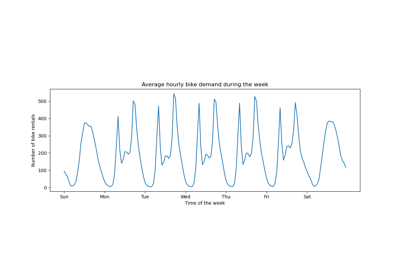sklearn.pipeline.FeatureUnion¶
- class sklearn.pipeline.FeatureUnion(transformer_list, *, n_jobs=None, transformer_weights=None, verbose=False)[source]¶
Concatenates results of multiple transformer objects.
This estimator applies a list of transformer objects in parallel to the input data, then concatenates the results. This is useful to combine several feature extraction mechanisms into a single transformer.
Parameters of the transformers may be set using its name and the parameter name separated by a ‘__’. A transformer may be replaced entirely by setting the parameter with its name to another transformer, removed by setting to ‘drop’ or disabled by setting to ‘passthrough’ (features are passed without transformation).
Read more in the User Guide.
New in version 0.13.
- Parameters:
- transformer_listlist of (str, transformer) tuples
List of transformer objects to be applied to the data. The first half of each tuple is the name of the transformer. The transformer can be ‘drop’ for it to be ignored or can be ‘passthrough’ for features to be passed unchanged.
New in version 1.1: Added the option
"passthrough".Changed in version 0.22: Deprecated
Noneas a transformer in favor of ‘drop’.- n_jobsint, default=None
Number of jobs to run in parallel.
Nonemeans 1 unless in ajoblib.parallel_backendcontext.-1means using all processors. See Glossary for more details.Changed in version v0.20:
n_jobsdefault changed from 1 to None- transformer_weightsdict, default=None
Multiplicative weights for features per transformer. Keys are transformer names, values the weights. Raises ValueError if key not present in
transformer_list.- verbosebool, default=False
If True, the time elapsed while fitting each transformer will be printed as it is completed.
- Attributes:
- named_transformers
Bunch Dictionary-like object, with the following attributes. Read-only attribute to access any transformer parameter by user given name. Keys are transformer names and values are transformer parameters.
New in version 1.2.
n_features_in_intNumber of features seen during fit.
- named_transformers
See also
make_unionConvenience function for simplified feature union construction.
Examples
>>> from sklearn.pipeline import FeatureUnion >>> from sklearn.decomposition import PCA, TruncatedSVD >>> union = FeatureUnion([("pca", PCA(n_components=1)), ... ("svd", TruncatedSVD(n_components=2))]) >>> X = [[0., 1., 3], [2., 2., 5]] >>> union.fit_transform(X) array([[ 1.5 , 3.0..., 0.8...], [-1.5 , 5.7..., -0.4...]])
Methods
fit(X[, y])Fit all transformers using X.
fit_transform(X[, y])Fit all transformers, transform the data and concatenate results.
get_feature_names_out([input_features])Get output feature names for transformation.
get_params([deep])Get parameters for this estimator.
set_output(*[, transform])Set the output container when
"transform"and"fit_transform"are called.set_params(**kwargs)Set the parameters of this estimator.
transform(X)Transform X separately by each transformer, concatenate results.
- fit(X, y=None, **fit_params)[source]¶
Fit all transformers using X.
- Parameters:
- Xiterable or array-like, depending on transformers
Input data, used to fit transformers.
- yarray-like of shape (n_samples, n_outputs), default=None
Targets for supervised learning.
- **fit_paramsdict, default=None
Parameters to pass to the fit method of the estimator.
- Returns:
- selfobject
FeatureUnion class instance.
- fit_transform(X, y=None, **fit_params)[source]¶
Fit all transformers, transform the data and concatenate results.
- Parameters:
- Xiterable or array-like, depending on transformers
Input data to be transformed.
- yarray-like of shape (n_samples, n_outputs), default=None
Targets for supervised learning.
- **fit_paramsdict, default=None
Parameters to pass to the fit method of the estimator.
- Returns:
- X_tarray-like or sparse matrix of shape (n_samples, sum_n_components)
The
hstackof results of transformers.sum_n_componentsis the sum ofn_components(output dimension) over transformers.
- get_feature_names_out(input_features=None)[source]¶
Get output feature names for transformation.
- Parameters:
- input_featuresarray-like of str or None, default=None
Input features.
- Returns:
- feature_names_outndarray of str objects
Transformed feature names.
- get_params(deep=True)[source]¶
Get parameters for this estimator.
Returns the parameters given in the constructor as well as the estimators contained within the
transformer_listof theFeatureUnion.- Parameters:
- deepbool, default=True
If True, will return the parameters for this estimator and contained subobjects that are estimators.
- Returns:
- paramsmapping of string to any
Parameter names mapped to their values.
- set_output(*, transform=None)[source]¶
Set the output container when
"transform"and"fit_transform"are called.set_outputwill set the output of all estimators intransformer_list.- Parameters:
- transform{“default”, “pandas”}, default=None
Configure output of
transformandfit_transform."default": Default output format of a transformer"pandas": DataFrame outputNone: Transform configuration is unchanged
- Returns:
- selfestimator instance
Estimator instance.
- set_params(**kwargs)[source]¶
Set the parameters of this estimator.
Valid parameter keys can be listed with
get_params(). Note that you can directly set the parameters of the estimators contained intransformer_list.- Parameters:
- **kwargsdict
Parameters of this estimator or parameters of estimators contained in
transform_list. Parameters of the transformers may be set using its name and the parameter name separated by a ‘__’.
- Returns:
- selfobject
FeatureUnion class instance.
- transform(X)[source]¶
Transform X separately by each transformer, concatenate results.
- Parameters:
- Xiterable or array-like, depending on transformers
Input data to be transformed.
- Returns:
- X_tarray-like or sparse matrix of shape (n_samples, sum_n_components)
The
hstackof results of transformers.sum_n_componentsis the sum ofn_components(output dimension) over transformers.

